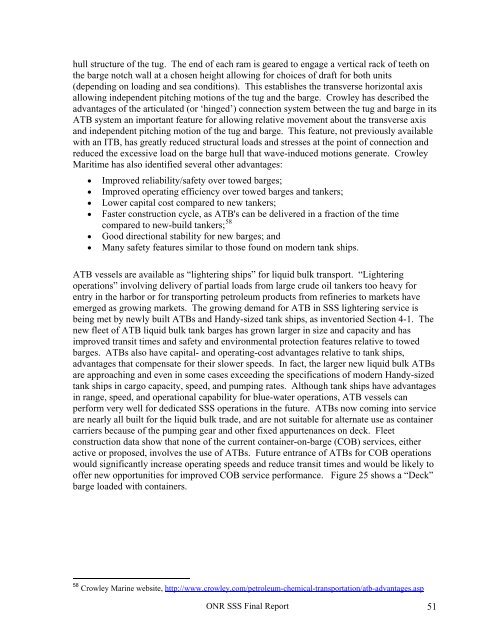Office of Naval Research - National Transportation Library
Office of Naval Research - National Transportation Library
Office of Naval Research - National Transportation Library
You also want an ePaper? Increase the reach of your titles
YUMPU automatically turns print PDFs into web optimized ePapers that Google loves.
hull structure <strong>of</strong> the tug. The end <strong>of</strong> each ram is geared to engage a vertical rack <strong>of</strong> teeth onthe barge notch wall at a chosen height allowing for choices <strong>of</strong> draft for both units(depending on loading and sea conditions). This establishes the transverse horizontal axisallowing independent pitching motions <strong>of</strong> the tug and the barge. Crowley has described theadvantages <strong>of</strong> the articulated (or ‘hinged’) connection system between the tug and barge in itsATB system an important feature for allowing relative movement about the transverse axisand independent pitching motion <strong>of</strong> the tug and barge. This feature, not previously availablewith an ITB, has greatly reduced structural loads and stresses at the point <strong>of</strong> connection andreduced the excessive load on the barge hull that wave-induced motions generate. CrowleyMaritime has also identified several other advantages:Improved reliability/safety over towed barges;Improved operating efficiency over towed barges and tankers;Lower capital cost compared to new tankers;Faster construction cycle, as ATB's can be delivered in a fraction <strong>of</strong> the timecompared to new-build tankers; 58Good directional stability for new barges; andMany safety features similar to those found on modern tank ships.ATB vessels are available as “lightering ships” for liquid bulk transport. “Lighteringoperations” involving delivery <strong>of</strong> partial loads from large crude oil tankers too heavy forentry in the harbor or for transporting petroleum products from refineries to markets haveemerged as growing markets. The growing demand for ATB in SSS lightering service isbeing met by newly built ATBs and Handy-sized tank ships, as inventoried Section 4-1. Thenew fleet <strong>of</strong> ATB liquid bulk tank barges has grown larger in size and capacity and hasimproved transit times and safety and environmental protection features relative to towedbarges. ATBs also have capital- and operating-cost advantages relative to tank ships,advantages that compensate for their slower speeds. In fact, the larger new liquid bulk ATBsare approaching and even in some cases exceeding the specifications <strong>of</strong> modern Handy-sizedtank ships in cargo capacity, speed, and pumping rates. Although tank ships have advantagesin range, speed, and operational capability for blue-water operations, ATB vessels canperform very well for dedicated SSS operations in the future. ATBs now coming into serviceare nearly all built for the liquid bulk trade, and are not suitable for alternate use as containercarriers because <strong>of</strong> the pumping gear and other fixed appurtenances on deck. Fleetconstruction data show that none <strong>of</strong> the current container-on-barge (COB) services, eitheractive or proposed, involves the use <strong>of</strong> ATBs. Future entrance <strong>of</strong> ATBs for COB operationswould significantly increase operating speeds and reduce transit times and would be likely to<strong>of</strong>fer new opportunities for improved COB service performance. Figure 25 shows a “Deck”barge loaded with containers.58 Crowley Marine website, http://www.crowley.com/petroleum-chemical-transportation/atb-advantages.aspONR SSS Final Report 51
















